If you’re a webmaster, then you love backlinks. You’re all about them, saying yes to every backlink opportunity like it’s your first date ever. You smile when you manage to get one, and you’re always looking for new link building openings.
But I’m about to tell you a story about a link that doesn’t bring you that much joy:
Someone read your article. They liked it. They contacted you, stating how interesting the information was and that they would link to it from their website. You’re just bursting with pride. After a few days pass, the link finally goes live. You smile as you open the page to check the link. When the page loads, your smile is instantly wiped off your face. It’s a nofollow …
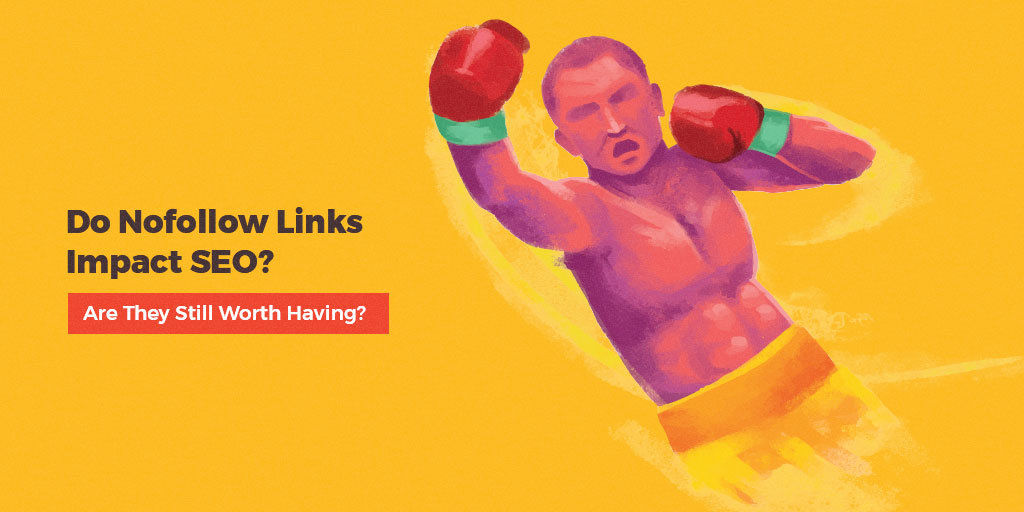
If you have a high nofollow link ratio, will it impact your overall SEO? And if yes, will it be in a negative or positive way? Everything you need to know about the impact nofollow links have on your website, backed up by case studies and Google’s position in this matter, can be found in the following lines.
- What Is a Nofollow Link?
- Why Are Publishers Switching to Nofollow Links?
- The Problem with Nofollow Links
- What Type of Links Google Says You Should Set as Nofollow?
- Are Links Worth Building Anymore if They are Nofollow?
Should you relate to the story above, I know how you feel. I’m not very keen on nofollow links either. Whenever I get one, I’m daydreaming about how it could’ve been a dofollow.
However, it seems like we’re only going to see more of them, as major publications have recently started adding the rel=”nofollow” attribute to all their external links.
Forbes and Inc. both silently began adding nofollow to all of their links. There’s a lot of link sellers that will hate that ?
— Matthew Howells-Barby (@matthewbarby) August 29, 2017
Whether you’re a link seller or just a webmaster, this can affect you in some way. But is this a good thing or a bad thing? Does this mean all links will eventually be nofollow?
Let’s find out!
What Is a Nofollow Link?
A nofollow link is a link that doesn’t pass equity or doesn’t vouch for the website it’s linking to. Links are a ranking factor for Google, and they act like votes. When you link to a website, you vote for its quality. If you don’t want to do that, you can add the nofollow attribute. It looks like this: <a href=”http://site.com” rel=”nofollow”>.
You probably already know what a nofollow link is. Most webmasters do. But while you might know what it is and what it does, you might not know the exact reason it was implemented for in the first place. This will be helpful in understanding the points I’ll try to make in the article.
Ever since people first found out that links and specific anchor texts can help them rank better in Google, they’ve been abusing the practice. One of the most common ways people would spam the web with links to their websites was through comments. A lot of websites had unmoderated comment sections, which meant you could simply post a comment and a link and it will immediately be live, regardless of its quality or purpose.
In 2005, Matt Cutts (at that time, Head of Spam at Google) and Jason Shellen (creator of Blogger) decided to introduce a new attribute to the <a> tag to combat comment spam. Technically, links marked with the nofollow attribute don’t pass a vote anymore. They just act like portals, as they can still be clicked on. Most platforms now offer nofollow links in the comments section by default.
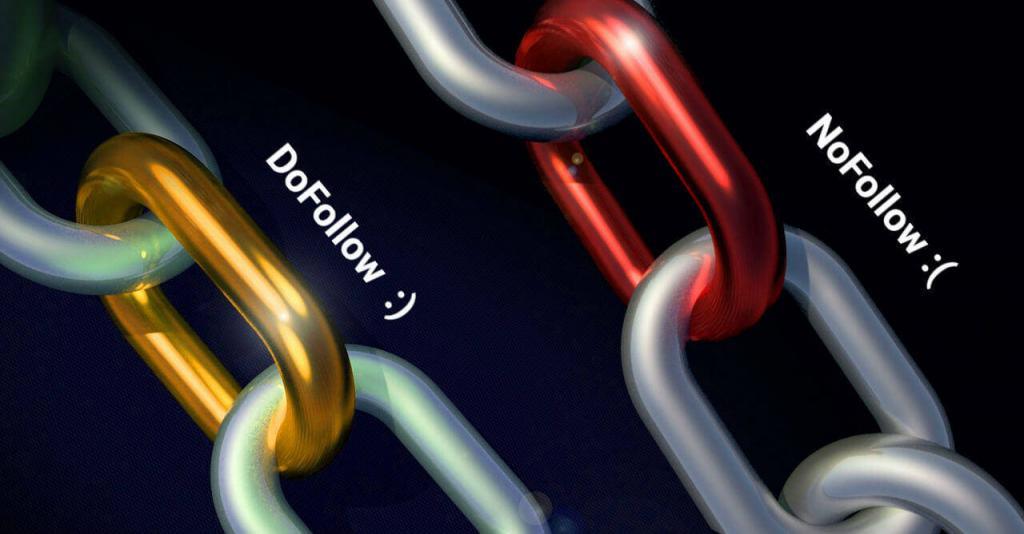
But the nofollow tag worked everywhere else too, not just in the comment section, so people started to use it for what we call PageRank Sculpting. If you have 4 links on your page, the score that your pages passes to the other pages through those links would be 100% / 4 => 25%. When using a nofollow tag on 3 links, it would pass all the equity through the remaining one.
In 2009 Google changed the way nofollow links work, hence now the passed value is split, regardless of whether the link is dofollow or nofollow. Having 3 nofollow links and 1 dofollow link will only pass 25% of the page’s full potential. The only way to pass more equity is to have fewer links on a page.
Ok, so this all makes sense and sounds good. But why are all the publishers massively switching all their external links to nofollow then? Why don’t they just use the nofollow attribute on advertisements?
Why Are Publishers Switching to Nofollow links?
The answer to this question is (probably) “because of fear”.
You see, webspam isn’t the only way people can influence rankings. There are also paid links. Paid links aren’t very good for Google, as it makes it hard to prove if a link is natural or incentivized.
But paid links are the core of advertising, therefore Google couldn’t completely make this against their guidelines. Instead, they made dofollow paid links against their guidelines.
At first, when checking out Google’s official page about paid links, it can get you confused as the page states that only PPC advertising can get away with a nofollow.
s
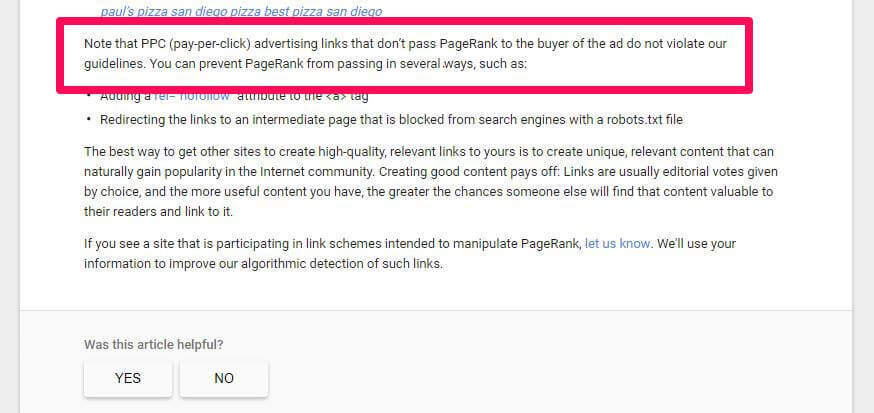
However, John Mueller from Google confirmed that any paid link is fine as long as it has the nofollow attribute.
Nofollow links are fine.
— John ☆.o(≧▽≦)o.☆ (@JohnMu) January 15, 2018
Now you might be thinking that the one that’s getting penalized is the site that builds the links, right? Well, in fact, both parties can suffer. If you’re accepting money to place a link and pretend that it’s editorial and natural, you’re harming the web, and Google will penalize you as well.
If you search for top publishers like “Huffington Post” on Fiverr, you can immediately see how big the market for selling links on these kinds of websites is.
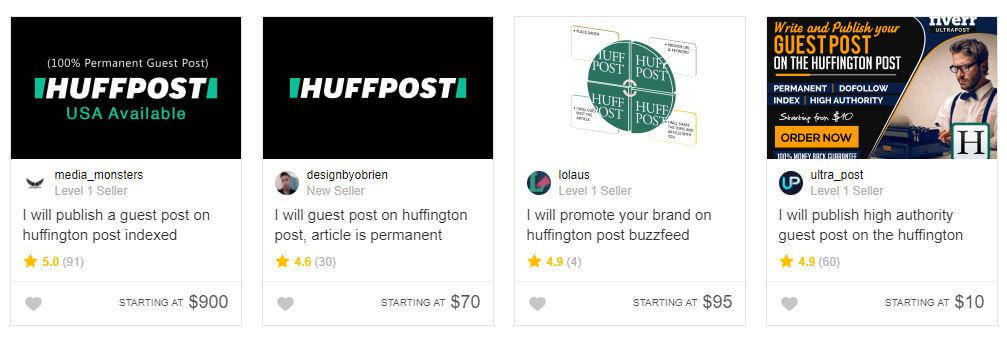
Screenshots from Fiverr, searching for “Huffington Post”
Monitoring all editors and proving whether a link has been paid or not is almost impossible to do, hence since they feared Google might penalize them, more and more publishers started adding a nofollow attribute to all their external links.
And Inc links are nofollowed now too. pic.twitter.com/sCQ8J20e0J
— Marie Haynes (@Marie_Haynes) August 29, 2017
This might fix the issue for the publisher… but it creates a lot of other issues in the world of SEO and search engines.
The Problem with Nofollow Links
You might think that, as the internet grows and SEO becomes more and more popular, the concept of passing a vote or not will too, and that people won’t want to pass votes.
Well, in reality, most of the links are dofollow. Nofollow links represent a very small percentage of all the links available on the web, and they’ve been around for more than 10 years now. Even Matt Cutts himself says something similar.
If your link profile is natural, you’ll probably also have a smaller number of nofollow links. There are more chances that an unnatural link profile will have more dofollow links, as their webmasters will try to build more of those. Here is an example from an analysis we made on the spammy links of a page that has only dofollow links to it (the cluster in the right, with blue lines only ). Shady, right?

So dofollow links are still the standard as far as natural links go. But as the above analysis shows, more and more major publishers start to switch to nofollow. This can definitely influence smaller publishers and webmasters to start doing this as well.
The switch can have big consequences. So far, we’re all passing a vote by default when we link to someone and we have to carefully pick who we don’t pass votes to. Whether we’re giving a link or we’re building one, we add nofollow for ourselves, not to raise any spam flags.
But if everything would be the other way around, and nobody will be passing link juice by default, we’ll have to specifically choose who to send our vote to.
I’m not saying that people are mean and they never want to link to other websites, but the negative factor is far more effective: I’d rather nofollow a link to ensure I don’t get penalized, than I would pass a vote to someone.
Google might not use links as a metric anymore
We all know links are important for ranking websites. Matt Cutts himself stated that links are still an important metric. Without them, search results are worse.
But if all the links are nofollow, then no equity is passed through them and, theoretically, Google isn’t following any of them. So, just to make some basic assumptions, if search results are worse without links, one of two things will happen:
1. Google will recommend not adding the nofollow tag to all the links, and will also probably apply a penalty to those who don’t pass link juice naturally. This, in my opinion, would be a really good idea.
If you want to link to your competitor because he has a great resource, you might as well do it without a nofollow. If not, go and spend some time to write the resource yourself and make sure to make it better, if you ever want it to rank.
Links are at the very core of the web. Obfuscating them in any way isn’t a good idea. And there are even more reasons explaining why nofollow links actually mean fewer links overall. Keep reading!
2. Google will have to take into consideration nofollow links. In fact, they most likely already do. The official Google page about the nofollow attribute says “in general”:

I don’t know about you, but for me, this means that they may not pass equity, but the might as well do.
On the other side, I asked John Mueller some time ago about this and he argues that if the links are nofollow, no signals will be passed. It’s a very interesting answer, in comparison with the official Google page statement.
Putting the two videos side by side (Matt Cutts’ and John Mueller’s) it’s kind of hard to say that links won’t matter in a world with a lot of nofollow links. Is Google transitioning to a world without links, and, instead of doing it suddenly, they are planning to do it gradually? I’m not sure, but it has happened before with Yandex (Yandex is the biggest search engine in Russia).
Dofollow links will become more “valuable”
Just like gold or bitcoins, the rarer followed links will be, the more valuable they will get. This means that these links will be more expensive, and people will pay more for them.
If people pay more for links, more webmasters will engage in selling links.
This isn’t a good thing, as followed links are the nature of the internet. If dofollow links become such a finite resource, people will make offers everywhere, and soon nobody will simply give dofollow links for free.
This will also affect the content quality around all link building efforts around the web.
If you’re guest blogging, you probably invest the time of writing that post to receive dofollow link in return. If you know that the link is nofollow, you might not put in the same amount of effort. A 300 words article might just do (or at least this is how some webmasters might think).
Webmasters are removing the comment section
Although webmasters usually remove comments because they’re hard to verify and don’t want any spam going on their website, these aren’t the only reasons.
Some of them will remove comment sections in order to hoard more link equity to specific links. Since Google changed the way nofollow links work (in 2009), having nofollow links on your pages affects the equity of your dofollow links.
This means that if you have 1 dofollow and 3 nofollow links on your page, you will only be passing 25% of the equity through the dofollow links, while 75% goes to complete waste.
This is a pretty harsh move from Google since nofollow would initially protect webmasters from spam, but now it also affects the link equity flow. So while this doesn’t benefit the spammer anymore, it now harms your website (reason good enough to keep spamming).
The logical outcome of this is people avoiding nofollow links altogether. Since comment sections are nofollow by default, removing the comments section is a quick solution to get away from those links.
A website called Above The Law did this back in 2016. You can check out their post about this here. Although comments on that post are still active, any other posts don’t seem to have the comment section enabled anymore.
They might’ve had their reasons, but this isn’t such a good idea, so don’t rush to follow them. Through comments, your website gets updated regularly with new content and shows the search engine that the content is not only good, but also engaging.
A better idea would be to remove the link section from your comments, but make comments possible. If you manually verify comments, it will still be hard, but comments are an indicator that your site is popular, and you should keep them. If you remove the links, you will have fewer spammers, and the average quality of the comments will grow, given that only the people who are really interested will bother to write.
Yet again, having only no nofollow links on your website might seem unnatural to Google, and might trigger other flags.
Also, consider that while linking to spammy sites is bad, linking to good ones has a benefit, and many SEOs recommend linking to good, relevant pages. This is an indication that you’re contributing to the web and trying to make it a better place. This also helps Google index quality pages better so, in theory, making the job easier for him, will benefit you as well.
Nofollow links don’t really make the web a better place
People still care more about the money than about their users. Julie Joyce wrote a nice article on this topic.
She mentioned that someone was trying to sell a link to her, but because of their commitment to the guidelines and their users’ experience, it must be a nofollow. Julie actually sent the wrong landing page for the link, and it appears that the webmaster didn’t have any problem adding an insurance link to a cake baking post.
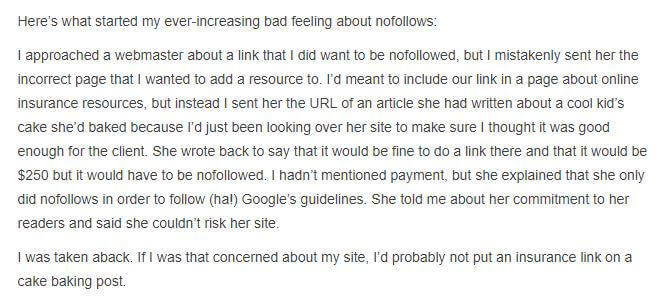
Snippet from Julie’s article
So much for user experience, right? If you cared so much about your readers, you wouldn’t accept putting an insurance company’s link on a cake baking post, be it follow or nofollow.
It’s still easy to get paid dofollow links
People will always find a way. In reality, Google can’t really know if you paid for a link or not. Matt Cutts talks about this in the following video but doesn’t really address the issue of how Google knows you’re paid for a link or not. You can check out the first comment on the video for more details.
However, there could be many ways Google could find out about your schemes. First one would be when someone reports you. Then, your website should theoretically go through a manual review.
Of course, people speculate some other methods Google uses. They could also be monitoring your e-mails, and any connections between your e-mail and your website could trigger a flag. You never know. There are also rumors of voice search being used to send ads, but it’s kind of extreme to say they listen to conversations to figure out whether you paid for some link.
But a dofollow link that looks 100% editorial isn’t that hard to get. The safest way would be to pursue them yourself instead of using a service. But, anyway, you can get one easily.
I’ve even found some dofollow links on Forbes. My search started some months ago when I saw some dofollow link building services on Facebook, claiming to get dofollow links on Forbes. I was curious, as this was after the rumors about Forbes turning all external links to nofollow.
I contacted a manager from Forbes and at first, they said they were unaware that that was happening. His answer sounded strange to me but, eventually, he did tell me that it was handed over to the legal department and that they had dealt with similar situations before.
Here’s another service, on a service trading website.
Here’s a dofollow link from Forbes. It’s noreffer and noopener, but it definitely does not contain the nofollow attribute.

On this post there is a dofollow backlink to MarketingLand. It seems that not all external links are nofollow!

These posts are both recent, after the claims that Forbes changed external links to nofollow.
Disclaimer: I’m not saying that these authors are selling dofollow links, I’m saying that it’s possible to get dofollow links on Forbes. I don’t know the internal policies of these publishers, but these links were dofollow at the time this article was written. Note that they might have changed it since then.
Nofollow links make things more complicated
It’s actually even more complicated for the good guys because if you want to follow a link, Google might now think you’ve been paid for it.
This is, as I said, one of the reasons publishers make all links nofollow, just to make sure there’s nothing suspicious about their links.
Genuine nofollow links can also get mixed with the spammy ones. Since they theoretically don’t pass any equity, people get confused when it comes to disavowing them. Should you disavow nofollow links or not?
There’s also the possibility that Google will actually follow a site you don’t want to endorse because, as they stated, nofollow links don’t pass equity “in general”. So if you want to give a negative example somewhere and add the nofollow attribute, who knows, maybe Google will rank it higher.
You might be asking yourself “Why link to it in the first place if it’s a bad site?”. Well, for the user’s experience. Obviously, you shouldn’t link to it if it has malware or anything, but you can link to it to provide a negative example of something. You don’t want to endorse that site.
There are plenty of examples around the web that prove nofollow links help you rank. We’ll talk about them soon.
What Type of Links Google Says You Should Set as Nofollow?
At first, these nofollow links were only for the comment sections. Yet later on, Google started expanding their usability to advertisements and other types of links.
Paid links & advertisements
Ok, so we know that Google says paid links and advertisements should be nofollow. But should you do it? The answer is yes. Unless you can ensure there are no patterns, the risk of you getting penalized is high.
Ads are easy to find. The patterns are usually obvious. Footer or sidebar? Probably an ad. Link in big flashy gif or image? Probably an ad. Link with an optimized anchor text on an article about a topic unrelated to the general subjects of that specific site? Probably a paid link.
You can see how easily you can find patterns just by searching things yourself. Now imagine what a super-computer like GoogleBot can do.
Links to sites you don’t trust
Google actually recommends doing this only against spam or links you can’t vouch for, like comments and other user-generated content. This actually makes sense for Forbes, as the authors on Forbes are basically … users that generate content, so Forbes itself can’t vouch for the quality of the links.
You can, however, nofollow any link you want. If the content looks spammy but you still think the link is relevant for your users, then you should nofollow that link. Also make sure it doesn’t have malware before you link to it. Linking to malicious websites will harm your website as well, as Google will try to protect its users.
Crawl prioritization
Linking to pages and areas Google can’t access is seen as a waste by the bot. By “nofollowing” those links, you (“in general”) prevent the bot from even trying to crawl them, as they don’t matter anyway.
This is something that many webmasters forget to do when they add custom login links on their own. This is actually something very different, as it’s the first time we’re talking about “nofollowing” an internal link.
Built with & Built by
Matt Cutts said once that using dofollow links in widgets and snippets that you widely distribute is suspicious and can become an abusive practice. Google now recommends that widgets (weather/forms/calculators) or footer links attributing a site’s creation to your company should be nofollowed. However, don’t avoid creating these links! If you build a nice website and people see it, they might be interested in contacting you through that footer link.
Also, if you’re a customer and your web-designer places a link on your website, think twice before asking him to remove it. It’s in your interest that his business survives, as you’re probably looking for a long-term collaboration.
Another thing that Google says it can be suspicious are widgets. So if you create any kind of widget, such as a weather or contact form, the links there should be nofollowed. Kind of dull, right?
To be honest, if I were to create a useful widget for others to use, I’d leave the link in it set as dofollow. I’d clearly state that there is a link inside it and that it’s copyrighted, hence without a link, it probably shouldn’t be used, but you can’t really dictate how they link to you as long as they do link.
If you instead ask for a dofollow link from the widget, it does look a lot like barter Deisng in exchange for PageRank => Hello Google penalty. But this isn’t Google’s main concern. People have been massively abusing widgets, adding links that have no connection whatsoever with the source of the widget. If people know about the existence of the link and still want to link to it, that’s fine. If you’re adding suspicious links or abusing the widget, it’s not cool anymore.
In fact, people can simply write the URL without even linking to it, and a DMCA report can’t be filed anymore because the citation is legit. In any case, a nofollow link is always better than no link at all.
Infographics & Guest Posts
Ok, you’re already probably annoyed. “Why would I not get dofollow links for my Infographics and Guest posts? I worked hard for them!”.
Forbes, for example, still has dofollow links towards their author’s websites, which is basically the foundation of guest blogging.
Well, although I don’t personally agree with this, Cutts does have a point:
| Ultimately, this is why we can’t have nice things in the SEO space: a trend starts out as authentic. Then more and more people pile on until only the barest trace of legitimate behavior remains. | |
 |
Matt Cutts |
| Former Head of Spam at Google / @mattcutts | |
In this post, an illustrator complains about this. Although I agree with Barry that I’d rather have a nofollow link than no link at all, I do have to give the designer some credit. People usually know they have to cite the source of an image. If you used it, you liked, which means you should credit it.
This demonstrates that nofollow has had a somewhat negative impact on the link building landscape.
Are Links Worth Building Anymore If They Are Nofollow?
The answer is definitely yes. You should still try to earn them.
First of all, there’s a lot of proof that nofollow links can actually help you rank better. You can check this article, which lists plenty of examples. In essence, the article suggests that Google endorses websites that advertise because this shows they’re in business and are willing to invest. It makes sense if you think about it. Spammy websites usually try to get everything for free.
There are a lot of benefits that nofollow links can bring you, especially from guest posts or mentions on reputable websites. Before search engines even existed, back when directories ruled the web, links didn’t matter the same way they do today. It was all about getting the user to your website. And that’s exactly what a nofollow link can still do today.
If you place a link on the right website, in the right place, you can benefit from exposure, traffic, and brand awareness. These links can also help you grow your social media audience and help your network. They’re also still a good channel for lead generation. Clients that come don’t really care if the link is nofollow or dofollow.
Having a nofollow link is way better than having no link at all, so don’t complain about them. If you can reach out to the author, don’t ask him to change the link. Build a connection. That’s the right way of getting a dofollow link, the next time they link to you.
Conclusion
Will all links be nofollow one day? Although this is a possibility, it’s unlikely to happen. At least not very soon. Nofollow links, although they help combat web spam, they are creating a whole lot more problems which are getting harder and harder to deal with.
Google will eventually have to take action, otherwise the nofollow won’t have a purpose anymore, and the metric won’t be relevant to the search engine.
I’m expecting something in the guidelines about how “nofollowing” all the outbound links on a website isn’t such a good idea because it doesn’t naturally pass the flow to sites that deserve it, purposely flawing the internet. Who knows, maybe one day there will even be a penalty for mass nofollow.
What I’m actually trying to say is that you shouldn’t nofollow as many links as you can. Give something back from time to time. Focus on building connections, and only nofollow paid links and ugly/malitious sites you don’t want to endorse, but you still need to link to. This could be the best way to win on the long-term!

 Site Explorer
Site Explorer Keyword tool
Keyword tool Google Algorithm Changes
Google Algorithm Changes

And yet, your tool give High link influence to noffolow links..
Cristian, I get your point. However, the link can be high quality, coming from relevant sites with good content, regardless whether it is a nofollow or not.
They are two different things.
Well, the thing is… how natural is a site to have a backlink profile of all Do Follow backlinks?
Let’s face it, if we are working on a brand new website, we have to build links. Generally, we try to do this while making it seem as natural as possible, this includes Dofollow links, Nofollow links, social media profile links, and even sometimes a little dabbling in manipulated/paid traffic (ugh uh I’m going to get some flask for this)
Or we can pretend we all write content as good as Adrian here that just naturally gets social media shares and backlinks…
What comes first? The Chicken or the egg?
🙂 Thanks for your comment, Mike.
I really don’t think a new site has to necessarily build links. I’ve been working on my own blog (written in my native language) and it’s been doing fine with rankings. First 2-3 months it was kinda nowhere, but after Google figured things out, it started ranking. over half of all my articles there are in the top 10. Didn’t really promote it either, only some Facebook shares. No links whatsoever. Yet, good content.
I guess the competition globally is definitely tougher. But it’s doable. There’s a video from Miles Beckler that states this very well.
https://www.youtube.com/watch?v=A8EI6JaFbv4&t=1s
My content gets the natural shares and links because it’s so good, and also because cognitiveSEO has constantly done this repeatedly over a very long period of time. Now, when we post, we usually rank high without doing anything, except high quality content.
After all, we are always trying to find out if this works or not with Google. More and more info on SEO and, yet, less certainties.
That could be true, however, you could see if from another perspective. Sticking to the basics, respecting the guidelines and doing it consistently for a longer period of time pays off.
Thanks for sharing this interesting article. Nowadays, most of the seo’s always look for the do follows links but, what they don’t know is to keep their link profile natural is very essential. So, no follow links also carries a huge impact on your seo.
The article was absolutely fantastic! A lot of great information which can be helpful in some or the other way. Keep updating the blog, looking forward for more content.
https://www.traffici5.com/